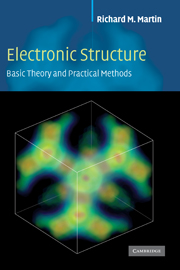Book contents
- Frontmatter
- Contents
- Preface
- Acknowledgments
- Notation
- Part I Overview and background topics
- Part II Density functional theory
- 6 Density functional theory: foundations
- 7 The Kohn–Sham auxiliary system
- 8 Functionals for exchange and correlation
- 9 Solving Kohn–Sham equations
- Part III Important preliminaries on atoms
- Part IV Determination of electronic structure: the three basic methods
- Part V Predicting properties of matter from electronic structure – recent developments
- Appendix A Functional equations
- Appendix B LSDA and GGA functionals
- Appendix C Adiabatic approximation
- Appendix D Response functions and Green's functions
- Appendix E Dielectric functions and optical properties
- Appendix F Coulomb interactions in extended systems
- Appendix G Stress from electronic structure
- Appendix H Energy and stress densities
- Appendix I Alternative force expressions
- Appendix J Scattering and phase shifts
- Appendix K Useful relations and formulas
- Appendix L Numerical methods
- Appendix M Iterative methods in electronic structure
- Appendix N Code for empirical pseudopotential and tight-binding
- Appendix O Units and conversion factors
- References
- Index
8 - Functionals for exchange and correlation
from Part II - Density functional theory
Published online by Cambridge University Press: 05 June 2012
- Frontmatter
- Contents
- Preface
- Acknowledgments
- Notation
- Part I Overview and background topics
- Part II Density functional theory
- 6 Density functional theory: foundations
- 7 The Kohn–Sham auxiliary system
- 8 Functionals for exchange and correlation
- 9 Solving Kohn–Sham equations
- Part III Important preliminaries on atoms
- Part IV Determination of electronic structure: the three basic methods
- Part V Predicting properties of matter from electronic structure – recent developments
- Appendix A Functional equations
- Appendix B LSDA and GGA functionals
- Appendix C Adiabatic approximation
- Appendix D Response functions and Green's functions
- Appendix E Dielectric functions and optical properties
- Appendix F Coulomb interactions in extended systems
- Appendix G Stress from electronic structure
- Appendix H Energy and stress densities
- Appendix I Alternative force expressions
- Appendix J Scattering and phase shifts
- Appendix K Useful relations and formulas
- Appendix L Numerical methods
- Appendix M Iterative methods in electronic structure
- Appendix N Code for empirical pseudopotential and tight-binding
- Appendix O Units and conversion factors
- References
- Index
Summary
Functional functionals
Summary
Density functional theory is the most widely used method today for electronic structure calculations because of the success of practical, approximate functionals. The crucial quantity in the Kohn–Sham approach is the exchange–correlation energy which is expressed as a functional of the density Exc[n]. This chapter is devoted to relevant approximate functionals, in particular, the local density approximation (LDA) and examples of generalized-gradient approximations (GGAs). Explicit formulas for certain widely used functionals are given in App. B. Non-local formulations are an active area of research leading to new classes of functionals, in particular, orbital-dependent functionals including the “optimized effective potential” (OEP) method and “hybrid functionals.” Important features are illustrated by a few selected results on atoms and molecules.
As emphasized in the previous chapter, the genius of the Kohn–Sham approach is two-fold: first, the construction of an auxiliary system leads to tractable independent-particle equations that hold the hope of solving interacting many-body problems. The famous Kohn–Sham equations are given in (7.11)–(7.13). Second, and perhaps more important, by explicitly separating out the independent-particle kinetic energy and the long-range Hartree terms, the remaining exchange–correlation functional Exc[n] can be reasonably approximated as a local or nearly local functional of the density. Even though the exact functional Exc[n] must be very complex, great progress has been made with remarkably simple approximations. This chapter is devoted to those approximations.
Information
- Type
- Chapter
- Information
- Electronic StructureBasic Theory and Practical Methods, pp. 152 - 171Publisher: Cambridge University PressPrint publication year: 2004
Accessibility standard: Unknown
Why this information is here
This section outlines the accessibility features of this content - including support for screen readers, full keyboard navigation and high-contrast display options. This may not be relevant for you.Accessibility Information
- 1
- Cited by
